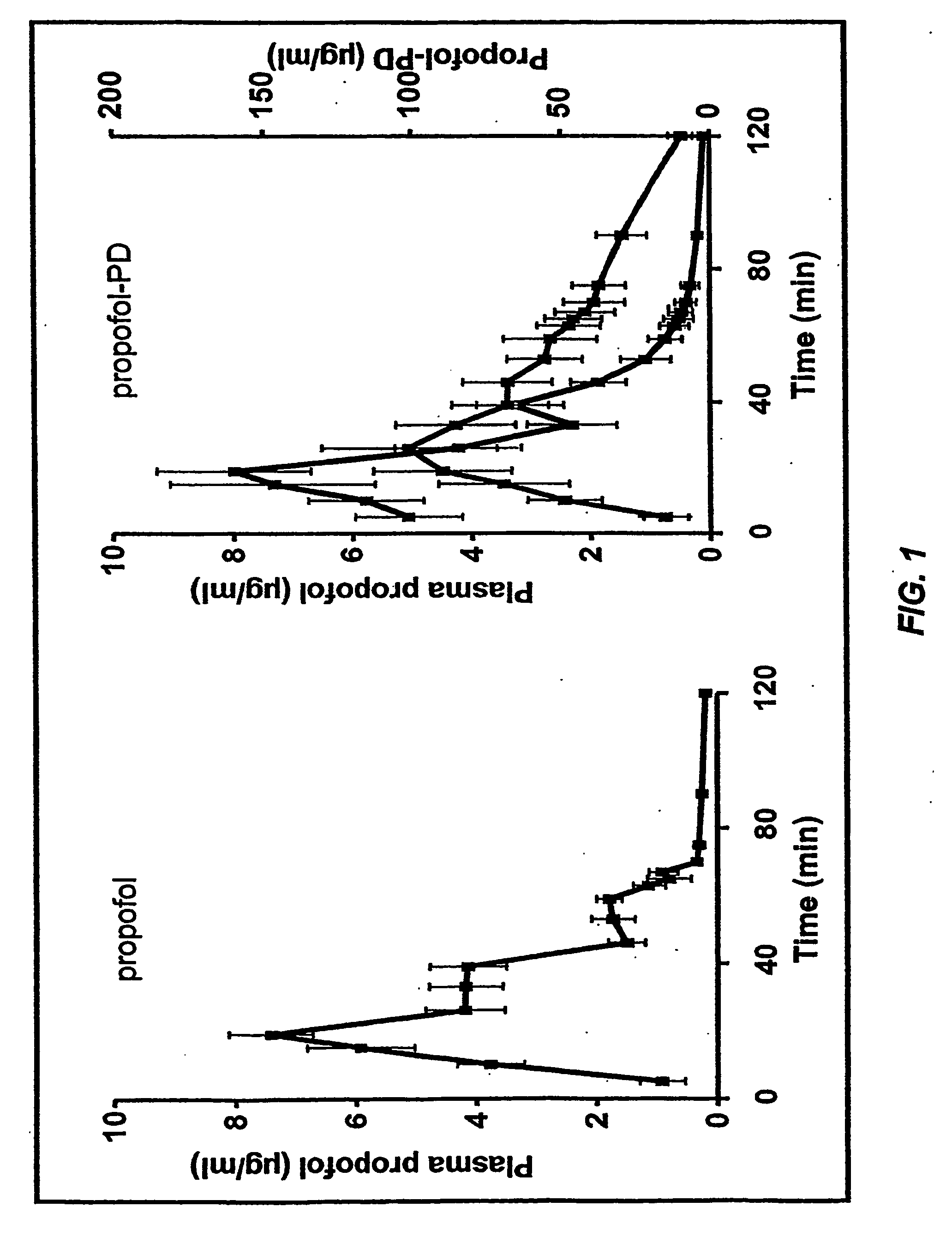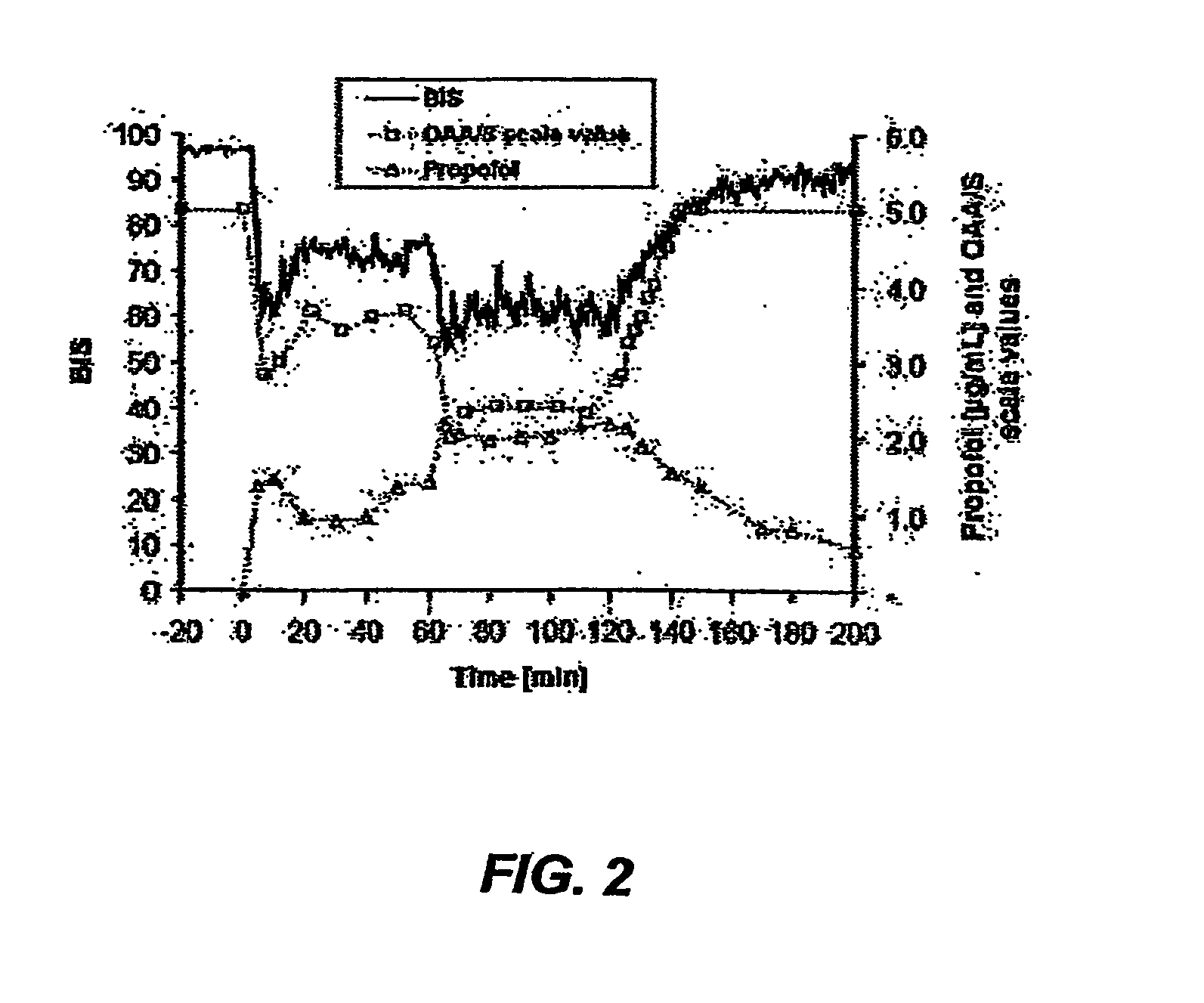Pharmaceutical compositions containing water-soluble prodrugs of propofol and methods of administering same
a technology of propofol and pharmaceutical compositions, which is applied in the direction of drug compositions, antinoxious agents, active ingredients of phosphorous compounds, etc., can solve the problems of limited shelf life, poor water soluble water content of propofol, and inability to detect bacterial or fungal contamination by visual inspection of the vial
- Summary
- Abstract
- Description
- Claims
- Application Information
AI Technical Summary
Benefits of technology
Problems solved by technology
Method used
Image
Examples
example 1
[0060] This example compares the effects of target controlled infusions (TCI) of propofol and of O-phosphonooxymethyl propofol disodium salt (AQUAVAN™) on electrical brain activity and consciousness of healthy male volunteers. A sterile solution was prepared in a 20 mL vial, with 20 mg / mL of AQUAVAN™ and 0.4 wt % NaCl. The pH of the solution was adjusted to 8.6±0.4 with HCl or NaOH, as needed.
[0061] Nine male volunteers (age 19 to 35 yrs., body wt. 70 to 86 kg) received propofol as a target controlled infusion (TCI) with three different target concentrations over 60 min. After a washout period of 14 days, the same volunteers received a TCI infusion of AQUAVAN™ with identical propofol target concentrations (crossover design). The infusion scheme was a linear increasing propofol concentration up to 5 micrograms / ml for the first 20 minutes, a target of 3 micrograms / ml for the following 20 minutes, and a target propofol plasma concentration of 1.5 micrograms / ml for the following 20 min...
example 2
[0065] This example demonstrates the effects of target controlled infusions (TCI) of AQUAVAN™ on levels of alertness and sedation of healthy volunteers. A sterile solution of AQUAVAN™ was prepared as described for Example 1, above.
[0066] Six female (28±3 yrs, 57±4 kg body weight) and 6 male (32±6 yrs., 78±9 kg body weight) volunteers were studied. For a period of 2 hours, a TCI infusion of AQUAVAN™ was administered to provide adequate sedation. The initially selected target concentration of propofol from AQUAVAN™ was 1.8 μg / ml. Sedation was rated as adequate if according to a modified Observers Assessment of Alertness and Sedation Scale (OAA / S) the OAA / S scale value was 2 to 3. After 60 minutes, the target concentration was increased to 2.4 or 3 μg / ml if the OAA / S scale value was 4 or 5, respectively, or reduced to 1.4 μg / ml if the OAA / S scale value was 0 to 1. With an Aspect® A-1000 monitor and two frontal leads the BIS values were recorded. The ECG, blood pressure, heart rate, Sa...
example 3
[0069] This example compares the pharmacodynamics of propofol when administered as a single, bolus dose of the prodrug O-phosphonooxymethyl-propofol di-sodium salt (AQUAVAN™) in accordance with the present invention, to the pharmacodynamics of propofol when administered as such. A sterile solution, the “study formulation,” was prepared in a 20 mL vial, with 20 mg / mL of AQUAVAN™ and 0.4 wt % NaCl. The pH of the solution was adjusted to 8.6±0.4 with HCl or NaOH, as needed.
[0070] Twenty-four healthy subjects (all ASA 1, 25±5 yrs., 70±8 kg) were randomized into 4 cohorts, with 3 male and 3 female in each. Each of the four cohorts was given a single dose of the study formulation described in Table 1 above (5, 10, 20, and 25 mg / kg, AQUAVAN™ respectively). Anesthetic effect was measured continuously using a BIS-XP monitor (Aspect Medical Systems, Natick, Mass.). The lowest BIS level (BISpeak) was recorded. One week later, propofol was given to the same individuals at a rapid infusion rate...
PUM
| Property | Measurement | Unit |
|---|---|---|
| concentration | aaaaa | aaaaa |
| concentration | aaaaa | aaaaa |
| concentration | aaaaa | aaaaa |
Abstract
Description
Claims
Application Information
 Login to View More
Login to View More - R&D
- Intellectual Property
- Life Sciences
- Materials
- Tech Scout
- Unparalleled Data Quality
- Higher Quality Content
- 60% Fewer Hallucinations
Browse by: Latest US Patents, China's latest patents, Technical Efficacy Thesaurus, Application Domain, Technology Topic, Popular Technical Reports.
© 2025 PatSnap. All rights reserved.Legal|Privacy policy|Modern Slavery Act Transparency Statement|Sitemap|About US| Contact US: help@patsnap.com



